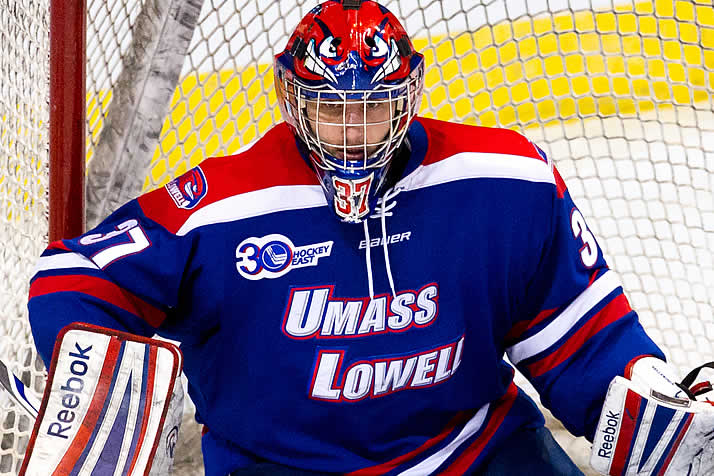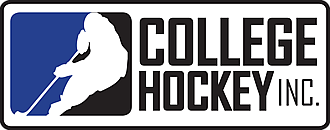Tuesday, May 25, 2021
Goalie Paths: How they Get to NCAA Division I
Study takes a closer look at the most important position on the ice

Note: This article was originally published May 25, 2021, and was most recently updated on May 29, 2024 .
By Nate Ewell and Sean Hogan
There’s no one path to reach NCAA Division I hockey, a tenet that is proven true over and over again.
Nowhere is it more true than at the goaltending position, where the winding roads from youth hockey to the college game resemble a plate of spaghetti.
It’s a path and a position that certainly rewards patience, as a closer look at current college goalies and their paths revealed. But that research also showed some surprises, including the ages that college goalies tend to enroll in school.
The Data: Junior Leagues
The simplest way to see how goaltenders got to the Division I level is to look where they played immediately prior to college. But while that’s simple on the surface, the data doesn’t paint a clear picture. No fewer than 20 different leagues committed goalies to Division I rosters in 2023-24.
College Hockey Inc. examined the 201 Division I men’s goaltenders in 2023-24. The results show a variety of leagues, mostly at the junior level – with 58 percent of all goaltenders committing while in the USHL, NAHL or BCHL.
Twelve other leagues produced more than one goaltender, though, proving that top goalies in any of those pre-college leagues can get Division I opportunities.
Here’s all the data:
| Where goalies committed from: | |
| League | No. |
| NAHL | 61 |
| USHL | 34 |
| BCHL | 21 |
| AJHL | 12 |
| NCDC | 11 |
| Prep | 10 |
| Europe | 8 |
| MJHL | 8 |
| CCHL | 7 |
| 16U AAA (U.S.) | 6 |
| NTDP | 4 |
| OJHL | 4 |
| No Data | 3 |
| SJHL | 3 |
| 18U AAA (U.S.) | 2 |
| U.S. HS (Minn.) | 2 |
| ACHA | 1 |
| U16 AAA (Canada) | 1 |
| EHL | 1 |
| NA3HL | 1 |
| NCAA Division III | 1 |
Focusing on primary starting goalies – defined as those who played at least 20 regular season games in 2023-224 – shows a bit more focus, but it’s still a wide funnel. The USHL, NAHL and BCHL lead the way in this group, but there are still 14 leagues committing starting goalies to the NCAA Division I level.
| Where goalies committed from – 2023-24 NCAA DI Goalies with 20+ GP | |
| League | No. |
| USHL | 13 |
| BCHL | 10 |
| NAHL | 10 |
| AJHL | 5 |
| 16U AAA (U.S.) | 4 |
| Europe | 3 |
| NTDP | 3 |
| CCHL | 2 |
| NCDC | 2 |
| OJHL | 2 |
| Prep | 2 |
| U.S. HS (Minn.) | 2 |
| MJHL | 1 |
| SJHL | 1 |
The Data: By Age
Looking beyond where NCAA DI goalies committed from yields even more interesting data. College Hockey Inc. looked at where current college goaltenders spent each of their junior-eligible seasons – at ages 16, 17, 18, 19 and 20. Here, we had two key findings:
First, there’s no need for goaltenders to rush to get to the junior hockey ranks. When we looked at Division I men’s goaltenders in 2023-24 and where they played at 17 years old, the majority (60%) were playing 18U, prep school, or high school hockey.
The three leagues that end up committing the most Division I goalies – the USHL, NAHL and BCHL – are home to only 13 percent of them at 17 years old. Goaltenders, the data shows, can be playing virtually anywhere at age 17 and still reach the top level of college hockey.
“This research reinforces an important point, that there’s no need for goaltenders to rush to junior hockey,” said Steve Thompson, USA Hockey’s American Development Model Manager of Goaltending. “Well over half of all Division I goaltenders played 18U, prep school or high school hockey as 17-year-olds. What’s important is that they are playing and developing at that age, not trying to advance too quickly.”
| At Age 17 – 2023-24 Goaltenders | |
| League | Pct. |
| 18U AAA (U.S.) | 44% |
| Prep | 33% |
| Europe | 18% |
| U18 AAA (Canada) | 14% |
| NAHL | 12% |
| USHL | 12% |
| U.S. HS (Minn.) | 12% |
| NTDP | 7% |
| OJHL | 7% |
| CSSHL | 5% |
| AJHL | 4% |
| Cdn. High School | 4% |
| U.S. HS (Mass.) | 4% |
| U.S. HS (Mich.) | 4% |
| BCHL | 3% |
| GOJHL | 3% |
| NCDC | 3% |
| CCHL | 2% |
| NA3HL | 2% |
| No data | 2% |
| PIJHL | 2% |
| Jr. C | 1% |
| MJHL | 1% |
| U.S. HS (N.D.) | 1% |
| U.S. HS (Wis.) | 1% |
Second, goaltenders reach college at varying ages. Among all NCAA goaltenders last year, 16 percent were playing college by the time they were 19.
Among starting goaltenders (20 regular season GP in 2023-24), 26 percent were playing college by age 19. Among the Division I goaltenders who signed NHL contracts between 2014-23, 51% were in college at 19.
| At Age 19 – Goaltenders Who Signed NHL Contracts from 2014-23 | |
| League | No. |
| NCAA | 32 |
| USHL | 16 |
| BCHL | 5 |
| NAHL | 5 |
| Europe | 2 |
| NCDC | 1 |
| SJHL | 1 |
| USPHL | 1 |
Successful goaltenders who do make the jump to college at age 18 or 19 tend to play a lot right away, rather than serving as a backup. Among that same group of goalies who signed NHL contracts, 66 percent of them who were NCAA freshmen at 18 or 19 played the majority of their team’s games that year.
That reinforces Thompson’s earlier point: for a goaltender, getting ice time can be more important than what level they are playing.
Case Study
The myriad ways that a goaltender can reach the Division I level may be best represented by a man at the top of his profession: Connor Hellebuyck.
Hellebuyck, who won the Vezina Trophy in 2019-20 and is a finalist for the award again in 2023-24, famously got his break at an NAHL tryout camp. He spent his 17-year-old season playing for Walled Lake Northern High School in Michigan before turning heads at tryouts for the Odessa Jackelopes.
Hellebuyck’s .930 save percentage in the NAHL earned him a scholarship to UMass Lowell and made him a fifth-round draft pick of the Jets. Two spectacular seasons in college led to a year and a half in the AHL before becoming an NHL starter.
Hellebuyck was 23 when he became the Winnipeg Jets’ No. 1 goaltender, which is younger than most of his peers. But he never rushed on the path to get there, which has paid the ultimate dividends in the end.
Similar paths were traveled by other NHL starting goaltenders, such as Jeremy Swayman (Maine), Alex Lyon (Yale) and Charlie Lindgren (St. Cloud State).
Thanks to eliteprospects.com for some of the data used in this research.
